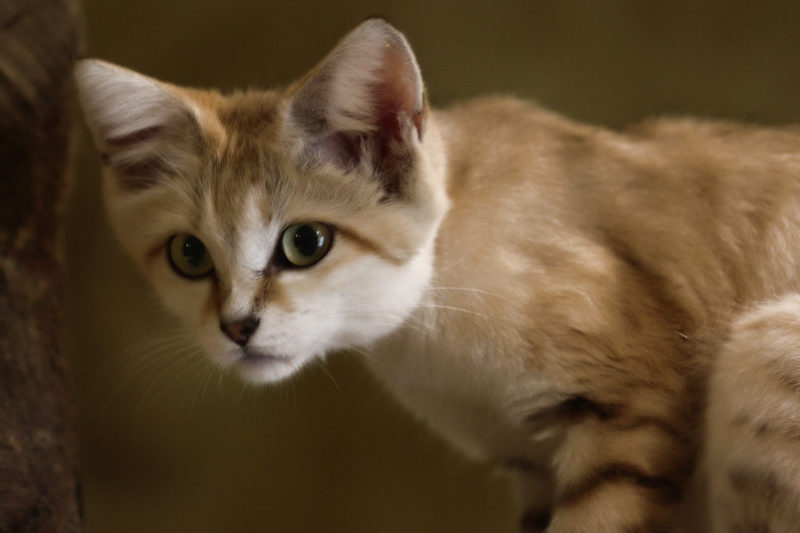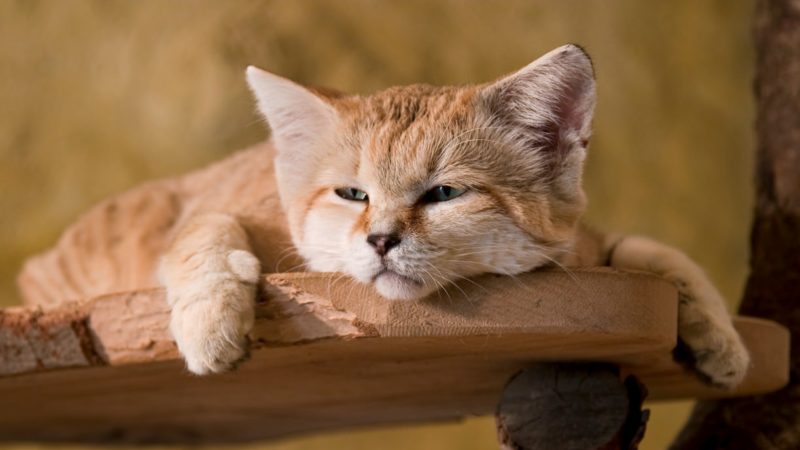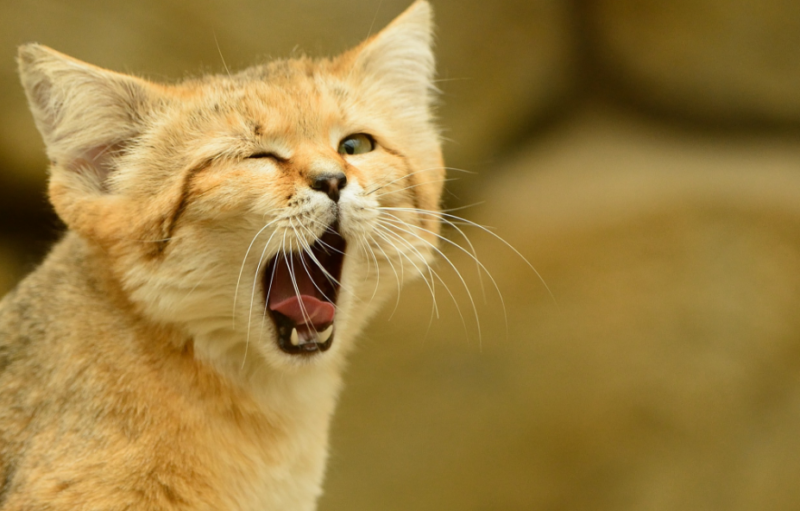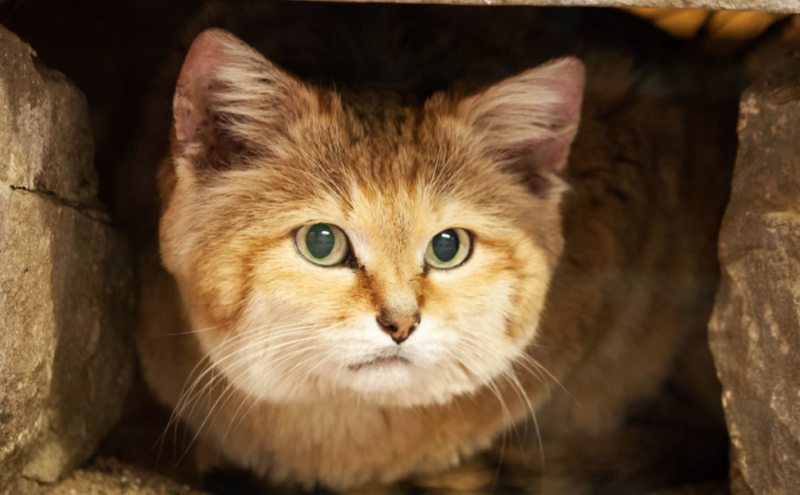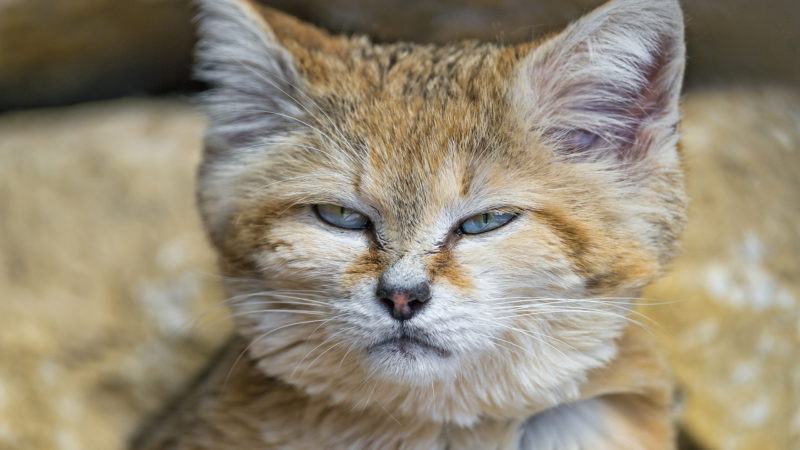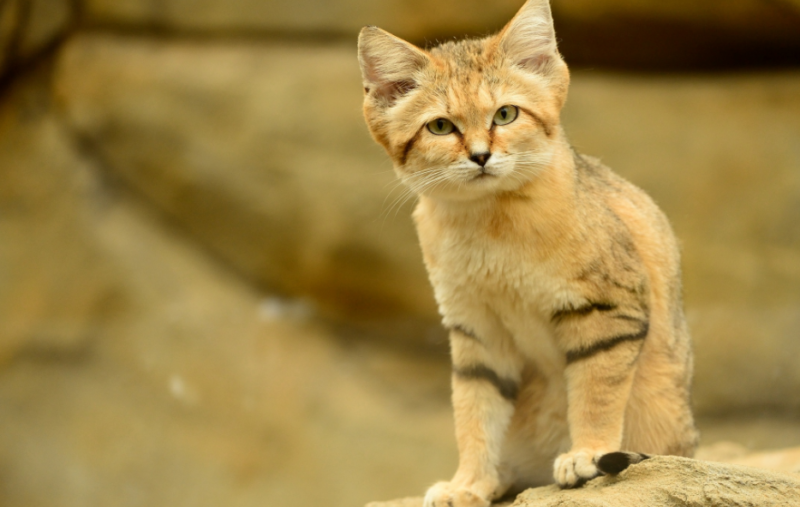The small size of the sand cat is often misleading to many people who believe that in front of them is a cute cat from those who live in apartments. But the sand cat is a predatory mammal belonging to the subfamily Small cats. What kind of animal it is and how it is interesting, we will analyze in this article.
Material Content:
Features and habitat of the dune cat
The sand cat is one of the representatives of the cat family. The length of his body can reach 90 cm, with 40% of the tail. Weight depends on the sex of the animal, but on average is 2.1 - 3.4 kg. The mass is commensurate with the height of the animal, which does not exceed 30 cm at the withers.
Distinctive characteristics of a predator are the following:
- head - large and noticeably flattened, with sideburns;
- ears are large and widely spaced, do not have tassels;
- eyes - almond-shaped, yellow with narrow pupils;
- limbs - short with well-developed paws;
- the coat is thick, due to which the animal does not feel cold at night and does not overheat during the day;
- color - sandy shades with grayish tones along the back, the tip of the tail has a coal color.
These predators easily tolerate drought, therefore, they are representatives of desert fauna.
They live in separate sections of the Sahara, in the deserts of the Arabian Peninsula, in central Asia and Pakistan.
Thanks to the hunt for small inhabitants of desert zones (rodents, lizards and even snakes), sand cats are able to survive in such an extreme environment.And sometimes, extremely rarely, they can be found in coastal rocky areas.
The nature, lifestyle and nutrition of a predator
Little wild cat leads a nocturnal lifestyle. With the onset of twilight, she goes hunting, and in the daytime sleeps, choosing for the night the burrows of foxes, porcupines. Sometimes representatives of the species can tear holes of smaller rodents.
Sand cat is a carnivorous mammal whose diet consists of gerbils, jerboas, lizards, large insects, spiders. It happens that the animal tries to feast on the hare-thalas and ruins the bird's nests. Sometimes the prey may be too large and then the cat buries the remains in the sand, making a supply in case of unsuccessful hunting.
A predatory mammal is considered an excellent hunter due to its paws, whose tracks in the sand are almost indistinguishable. It receives most of the water supply with food, so it can easily survive periods of lack of clean water.
Reproduction and longevity
The average life expectancy of dune cats is about 12 to 13 years. During the mating period, representatives of the genus can be met in pairs, which at other times is simply impossible. There is no clear time frame for the mating season, since they depend on the climatic conditions of the habitat. The males inform about readiness for mating with sounds reminiscent of barking.
Females prepare for childbirth in spacious minks. In a litter, as a rule, there are 4–5 kittens weighing no more than 30 g. Moreover, like domestic cats, offspring are born blind.
Kittens stay with the female for a maximum of 8 months, after which they switch to “free bread”. Mortality in the period before puberty, fixed in 9-15 months, is 40%.
Hunting and natural enemies
A dune cat (Felis margarita) hunts in the dark, overcoming a distance of 10 km.
Among natural enemies, except for a person who catches a predator for the purpose of subsequent sale, there are:
- jackals;
- Wolves
- large birds of prey.
Today, animals are protected by protective organizations. But at the moment it is difficult to determine the number of representatives of exotic fauna due to their secretive lifestyle.
The hunting of a sand cat is also very successful for snakes, including horned vipers. In the winter, when there are often hungry times, cats are seen near human settlements, but they attack the household very rarely.
It is interesting! When the area is illuminated by moonlight, the mammal sits down and squints before making the jump. And in order to hide its smell, which can frighten off potential prey, the animal buries feces very deeply.
Is it possible to keep at home
Wild sand cat easily becomes a pet. It’s no harder to accustom him to a tray than a regular domestic cat. However, growing a dune cat in captivity, you must remember the hunting nature of the animal. A large number of toys made from natural materials should be purchased so that interior items do not suffer. Ideally, it is recommended to periodically allow the predatory mammal to realize its hunting instincts.
It is also necessary to pay attention to the diet, giving preference to high-quality meat and fish products, which should form the basis of the menu. The meat should be lean and with bones. Dry food familiar to pets should be avoided. To compensate for the lack of calcium, you can sometimes give it to a predator in the form of tablets bought in a veterinary pharmacy.
Interesting facts about the dune cat
The most interesting facts known for certain about these predators:
- With the advent of winter, the inhabitants found in the vast territories of Central Asia, noted "winter" fur - more dense with a grayish tint.
- The ears of the animal are directed to the bottom, which allows him to record even minor movement of prey.And thanks to its small size, the cat catches prey in a lightning-fast jump.
- Loud barking sounds of dune cats are noted only before mating, at other times they are meowing and sometimes purring animals.
- Before leaving the hole, the cat carefully listens to the surrounding sounds and assesses the security of the situation, and after the sortie, the cat in the same way finds out if its shelter was occupied during the absence.
A sand cat is a wild carnivore that can, with proper care, become a domesticated pet and the pride of its owners.


